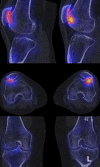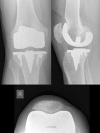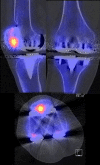Combined single photon emission computerised tomography and conventional computerised tomography (SPECT/CT) in patellofemoral disorders: a clinical review
- PMID: 20512329
- PMCID: PMC3080508
- DOI: 10.1007/s00264-010-1049-x
Combined single photon emission computerised tomography and conventional computerised tomography (SPECT/CT) in patellofemoral disorders: a clinical review
Abstract
Patellofemoral disorders are common conditions seen in a knee clinic but can present a great diagnostic challenge to the orthopaedic surgeon. Combined single photon emission computerised tomography with conventional computer tomography (SPECT/CT) provides the clinician with precise anatomical and physiological information of the patellofemoral joint. We present a clinical review that highlights the value of SPECT/CT in patients with patellofemoral disorders, where other modalities such as radiographs, MRI, and conventional CT did not provide sufficient information. SPECT/CT has proven to be helpful for establishing the diagnosis and guidance for further treatment. SPECT/CT should be recognised as a valuable diagnostic tool in orthopaedic patients.
Figures






Similar articles
-
Clinical value of SPECT/CT in the painful total knee arthroplasty (TKA): a prospective study in a consecutive series of 100 TKA.Eur J Nucl Med Mol Imaging. 2015 Nov;42(12):1869-82. doi: 10.1007/s00259-015-3095-5. Epub 2015 Jun 6. Eur J Nucl Med Mol Imaging. 2015. PMID: 26044121
-
Assessment of in vivo loading history of the patellofemoral joint: a study combining patellar position, tilt, alignment and bone SPECT/CT.Knee Surg Sports Traumatol Arthrosc. 2014 Dec;22(12):3039-46. doi: 10.1007/s00167-013-2698-2. Epub 2013 Oct 11. Knee Surg Sports Traumatol Arthrosc. 2014. PMID: 24114353
-
Clinical value of combined single photon emission computerized tomography and conventional computer tomography (SPECT/CT) in sports medicine.Sports Med Arthrosc Rev. 2011 Jun;19(2):174-81. doi: 10.1097/JSA.0b013e3181ec8707. Sports Med Arthrosc Rev. 2011. PMID: 21540716 Review.
-
Bone SPECT/CT has excellent sensitivity and specificity for diagnosis of loosening and patellofemoral problems after total knee arthroplasty.Knee Surg Sports Traumatol Arthrosc. 2020 Apr;28(4):1029-1035. doi: 10.1007/s00167-019-05609-w. Epub 2019 Jul 1. Knee Surg Sports Traumatol Arthrosc. 2020. PMID: 31263926
-
The role of single-photon emission computed tomography/computed tomography in benign and malignant bone disease.Semin Nucl Med. 2006 Oct;36(4):286-94. doi: 10.1053/j.semnuclmed.2006.05.001. Semin Nucl Med. 2006. PMID: 16950146 Review.
Cited by
-
Clinical value of SPECT/CT in the painful total knee arthroplasty (TKA): a prospective study in a consecutive series of 100 TKA.Eur J Nucl Med Mol Imaging. 2015 Nov;42(12):1869-82. doi: 10.1007/s00259-015-3095-5. Epub 2015 Jun 6. Eur J Nucl Med Mol Imaging. 2015. PMID: 26044121
-
Chondral Injury in Patellofemoral Instability.Cartilage. 2014 Jul;5(3):136-44. doi: 10.1177/1947603514530142. Cartilage. 2014. PMID: 26069693 Free PMC article.
-
Patterns of bone tracer uptake on SPECT-CT in symptomatic and asymptomatic patients with primary total hip arthroplasty.Eur J Nucl Med Mol Imaging. 2018 Feb;45(2):283-291. doi: 10.1007/s00259-017-3827-9. Epub 2017 Sep 19. Eur J Nucl Med Mol Imaging. 2018. PMID: 28929195
-
Assessment of in vivo loading history of the patellofemoral joint: a study combining patellar position, tilt, alignment and bone SPECT/CT.Knee Surg Sports Traumatol Arthrosc. 2014 Dec;22(12):3039-46. doi: 10.1007/s00167-013-2698-2. Epub 2013 Oct 11. Knee Surg Sports Traumatol Arthrosc. 2014. PMID: 24114353
-
Is hybrid imaging (SPECT/CT) a useful adjunct in the management of suspected facet joints arthropathy?Int Orthop. 2013 May;37(5):865-70. doi: 10.1007/s00264-013-1811-y. Epub 2013 Feb 15. Int Orthop. 2013. PMID: 23412368 Free PMC article.
References
-
- Fulkerson JP (1983) The etiology of patellofemoral pain in young, active patients: a prospective study. Clin Orthop Relat Res:129–133 - PubMed
-
- Fulkerson JP. Patellofemoral pain disorders: evaluation and management. J Am Acad Orthop Surg. 1994;2:124–132. - PubMed
-
- Fulkerson JP. Diagnosis and treatment of patients with patellofemoral pain. Am J Sports Med. 2002;30:447–456. - PubMed
-
- LaBella C. Patellofemoral pain syndrome: evaluation and treatment. Prim Care. 2004;31:977–1003. - PubMed

